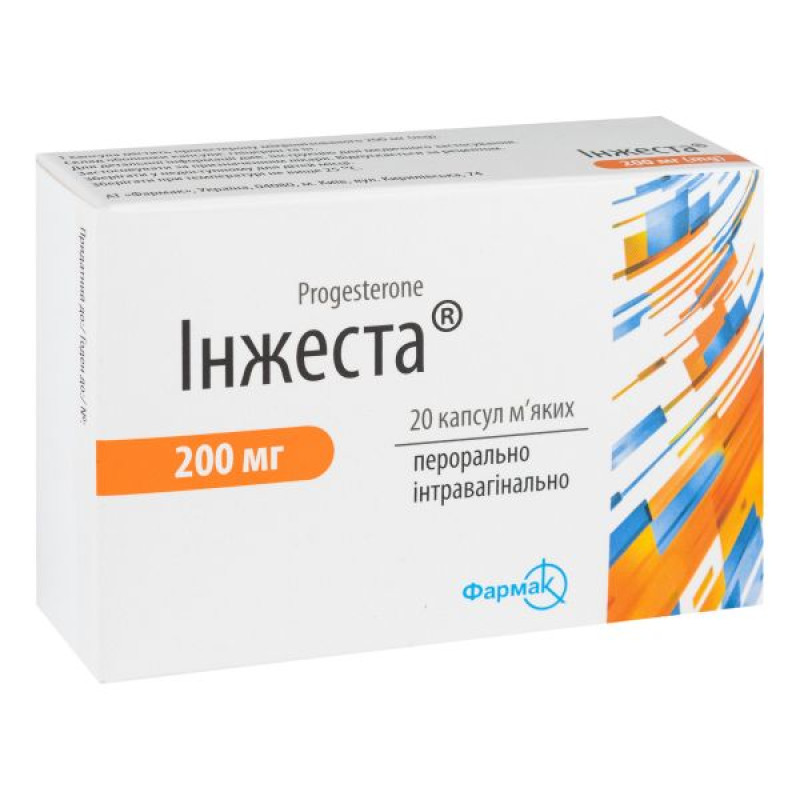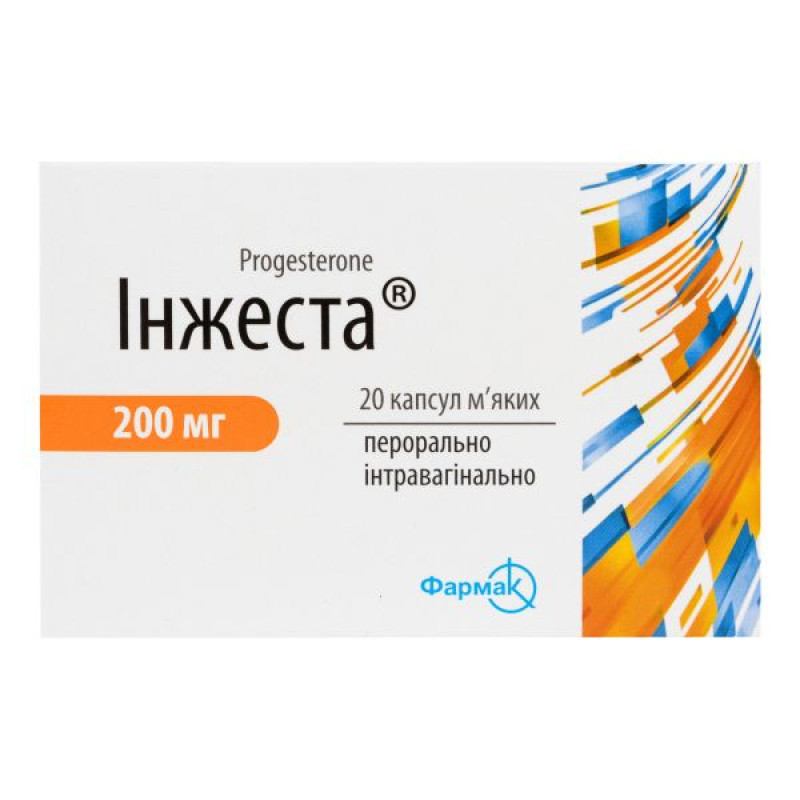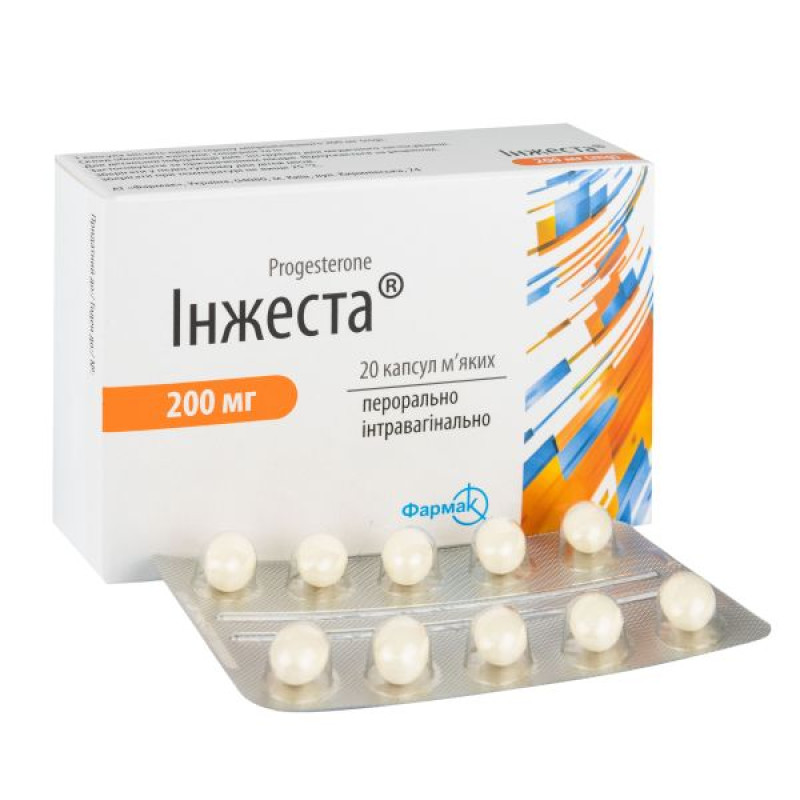Ingesta 200 mg capsules No. 20

Instructions for Ingest 200 mg capsules No. 20
Composition
active ingredient: micronized progesterone;
1 capsule contains 100 mg or 200 mg of micronized progesterone;
excipients: lecithin, sunflower oil;
capsule shell composition: gelatin, glycerin, titanium dioxide (E 171).
Dosage form
Soft capsules.
Main physicochemical properties:
100 mg capsules: soft gelatin capsules, round in shape, yellowish in color. The contents of the capsules are an oily, pasty mixture, almost white in color;
200 mg capsules: soft gelatin capsules, oval in shape, yellowish in color. The contents of the capsules are an oily, pasty mixture, almost white in color.
Pharmacotherapeutic group
Sex gland hormones. Progestogens. ATX code G03D A04.
Pharmacological properties
Pharmacodynamics
The pharmacological properties of the drug are due to progesterone - one of the hormones of the corpus luteum, which contributes to the formation of a normal secretory endometrium in women. It causes the transition of the uterine mucosa from the proliferation phase to the secretory phase, and after fertilization, it promotes its transition to the state necessary for the development of a fertilized egg. Reduces the excitability and contractility of the muscles of the uterus and fallopian tubes. It has no androgenic activity. It has a blocking effect on the secretion of hypothalamic LH and FSH releasing factors, inhibits the formation of gonadotropic hormones by the pituitary gland and ovulation.
Pharmacokinetics
Oral use
The level of progesterone in the blood plasma is increased from the first hour after absorption of the drug in the digestive tract. The highest level of progesterone in the blood plasma is observed 1-3 hours after taking the drug (after 1 hour - 4.25 ng/ml, after 2 hours - 11.75 ng/ml, after 4 hours - 8.37 ng/ml, after 6 hours - 2 ng/ml and after 8 hours - 1.64 ng/ml). The main metabolites of progesterone in the blood plasma are 20α-hydroxy,δ4α-pregnanolone and 5α-dihydroprogesterone. The drug is excreted in the urine in the form of glucuronic metabolites, the main of which is 3α,5β-pregnanediol (pregnanediol). These metabolites are identical to those formed during physiological secretion of the corpus luteum.
Intravaginal use
After insertion into the vagina, progesterone is rapidly absorbed by the mucous membrane.
The increase in progesterone levels in blood plasma begins within the first hour, with the highest level in blood plasma being reached 1-3 hours after administration of the drug.
At the average prescribed dose (100 mg of progesterone per night), Ingesta® allows achieving and maintaining a physiological and stable level of plasma progesterone (on average at the level of 9.7 ng/ml), similar to that in the luteal phase of the menstrual cycle with normal ovulation. Thus, the drug Ingesta® stimulates adequate maturation of the endometrium, promotes embryo implantation.
At higher doses (above 200 mg per day), which are increased gradually, the vaginal route of administration allows achieving a level of progesterone in the blood plasma similar to that during the first trimester of pregnancy.
Metabolism: metabolites in blood plasma and urine are identical to those found in the physiological secretion of the corpus luteum: in blood plasma, these are mainly 20α-hydroxy, δ4α-pregnanolone and 5α-dihydroprogesterone. Urinary excretion is 95% in the form of glucuronic metabolites, the main component of which is 3α,5β-pregnanediol (pregnanediol).
Indication
Disorders associated with progesterone deficiency.
Oral use
Gynecological:
– disorders associated with progesterone deficiency, namely:
– premenstrual syndrome,
– menstrual cycle disorders (dysovulation, anovulation),
– fibrocystic mastopathy,
– premenopause;
– hormone replacement therapy in menopause (in combination with estrogen therapy);
– infertility due to luteal insufficiency.
Obstetric:
– prevention of habitual miscarriage or threatened miscarriage against the background of luteal insufficiency;
– the threat of premature birth.
Intravaginal use
– Reduced ability to fertilize in primary or secondary infertility with partial or complete luteal insufficiency (dysovulation, luteal phase support during preparation for in vitro fertilization, egg donation program). Prevention of habitual miscarriage or threatened spontaneous miscarriage in luteal insufficiency.
– Prevention of preterm birth in women with a short cervix or in women with a history of spontaneous preterm birth.
– Impossibility or limitation of oral administration of the drug.
Contraindication
– Hypersensitivity to any component of the drug.
– Severe liver dysfunction.
– Suspected or confirmed breast or genital neoplasia.
– Undiagnosed vaginal bleeding.
– Failed or incomplete abortion.
– Thrombophlebitis. Thromboembolic disorders.
– Brain hemorrhage.
– Porphyria.
Interaction with other medicinal products and other types of interactions
When using estrogen for menopausal hormone therapy, it is strongly recommended to administer progesterone no later than the 12th day of the cycle.
Concomitant use of other drugs may alter progesterone metabolism, causing an increase or decrease in progesterone plasma concentrations and, consequently, altering the drug's action.
Powerful inducers of liver enzymes (barbiturates, antiepileptic drugs (phenytoin), rifampicin, phenylbutazone, spironolactone, griseofulvin) cause increased metabolism at the hepatic level.
Some antibiotics (ampicillins, tetracyclines) can cause changes in the intestinal microflora, resulting in a change in the enterohepatic steroid cycle.
It is known that such drug interactions are individual and may differ significantly in different patient groups, therefore it is impossible to predict any clinical manifestations of such interactions with certainty. All progestins may reduce glucose tolerance, which may require an increase in the daily dose of insulin and other antidiabetic agents in patients with diabetes.
Progesterone bioavailability can be reduced by smoking and increased by alcohol.
Application features
Treatment at recommended doses has no contraceptive effect.
If the treatment course begins too early - at the beginning of the menstrual cycle, especially before the 15th day of the cycle, you may experience a shortening of the cycle or bleeding.
In case of uterine bleeding, do not prescribe the drug without clarifying the cause, in particular during endometrial examination.
The drug should be used with caution in patients with fluid retention (for example, in diseases such as hypertension, cardiovascular disease, kidney disease, epilepsy, migraine, bronchial asthma), with a history of depression, with diabetes mellitus, liver dysfunction, and photosensitivity.
Before prescribing the drug, patients with a family history of neoplasms and patients with recurrent cholestasis or persistent itching during pregnancy, liver dysfunction, heart or kidney failure, fibrocystic mastopathy, epilepsy, asthma, otosclerosis, diabetes mellitus, multiple sclerosis, systemic lupus erythematosus should be carefully examined.
Due to the thromboembolic and metabolic risk, which cannot be completely ruled out, the drug should be discontinued in the event of:
– visual disturbances, such as vision loss, double vision, retinal vascular lesions, proptosis, optic disc edema;
– thromboembolic venous or thrombotic complications, regardless of the site of the lesion;
– severe headache, migraine.
If amenorrhea occurs during treatment, pregnancy, which may be the cause of amenorrhea, should be confirmed or ruled out.
When using the drug vaginally, oily discharge is possible, which is associated with the dosage form of the drug.
More than half of early spontaneous abortions are caused by genetic complications. Also, infectious manifestations and mechanical disorders can be the cause of early abortions; the only justification for prescribing progesterone would then be to delay the expulsion of a dead egg. Therefore, the prescription of progesterone on the recommendation of a doctor should be provided for cases where progesterone secretion is insufficient.
Before starting treatment, the patient should undergo a thorough medical and accurate gynecological examination, including intravaginal and mammological examination, Papanicolaou smear, taking into account the anamnesis, contraindications and precautions for use. Regular check-ups with a doctor are recommended during treatment. Women receiving hormone replacement therapy should carefully assess all the risks/benefits associated with therapy.
In patients with postmenopausal symptoms who are receiving or have received hormone replacement therapy (HRT), there is a slight to moderate increase in the likelihood of being diagnosed with breast cancer. This may be due to early diagnosis of patients or the actual benefit of HRT, as well as a combination of both. The risk of being diagnosed with breast cancer increases with increasing duration of treatment and returns to baseline values five years after stopping HRT. Breast cancer diagnosed in patients who are receiving or have recently received HRT is less invasive than that occurring in women who have not received HRT. The doctor should discuss the higher risk of developing breast cancer with patients who will receive long-term hormone therapy when assessing the benefits of HRT.
The drug should not be taken with food, but should be taken before bedtime. Simultaneous consumption of food increases the bioavailability of the drug.
Use during pregnancy or breastfeeding
The use of Ingesta® is not contraindicated during pregnancy, including the first weeks (see section “Indications” (“Obstetric indications”)).
During the period of use of the drug, no case of adverse effects of the drug on the fetus was observed.
When using the drug in the II and III trimesters of pregnancy, monitoring of liver function is required.
The passage of progesterone into breast milk has not been studied in detail. Therefore, its administration should be avoided during breastfeeding.
There is evidence of the possible development of hypospadias when progestogens are used during pregnancy to prevent spontaneous abortion or threatened abortion due to luteal insufficiency, which the patient should be informed about.
Ability to influence reaction speed when driving vehicles or other mechanisms
For drivers and machine operators: drowsiness and dizziness are possible when taking the drug internally.
Taking the capsules before bedtime helps to avoid these unpleasant consequences.
Cases of drowsiness and dizziness were observed only during oral administration of the drug.
Method of administration and doses
The duration of treatment depends on the nature of the disease.
Oral use
In most cases, the average daily dose is 200-300 mg in 1 or 2 doses (200 mg in the evening, before bedtime, and 100 mg in the morning, if necessary).
– In case of luteal phase insufficiency (premenstrual syndrome, menstrual cycle disorders, premenopause, fibrocystic mastopathy): take for 10 days (usually from the 17th to the 26th day of the cycle, inclusive).
– In menopausal hormone replacement therapy: since estrogen therapy alone is not recommended, progesterone should be used as a supplement to it for the last 2 weeks of each therapeutic course, which follow a one-week maintenance of any replacement therapy, during which withdrawal bleeding may occur.
– In case of threatened premature birth: take 400 mg of the drug every 6-8 hours until the symptoms disappear. The effective dose and frequency of use are selected individually depending on the clinical manifestations of the threat of premature birth. After the symptoms disappear, the dose of the drug is gradually reduced to a maintenance dose (for example, 200 mg 3 times a day). In this dose, the drug can be used up to 36 weeks of pregnancy.
The use of progesterone after 36 weeks of pregnancy is not recommended.
Intravaginal use
Insert the capsules deep into the vagina while lying on your back.
Before each use of the drug, it is necessary to wash your hands thoroughly so that no detergent remains on your hands.
The average dose is 200 mg of progesterone per day (1 capsule of 200 mg or 2 capsules of 100 mg, divided into 2 doses, morning and evening, which are inserted deep into the vagina, if necessary using an applicator). The dose can be increased depending on the patient's response.
– In case of partial luteal phase insufficiency (dysovulation, menstrual cycle disorders), the daily dose is 200 mg for 10 days (usually from the 17th to the 26th day of the cycle).
– In case of complete luteal phase deficiency [complete absence of progesterone in women with non-functioning (absent) ovaries (egg donation)]: the dose of progesterone is 100 mg on the 13th and 14th days of the transfer cycle. From the 15th to the 25th day of the cycle, the dose of progesterone is 200 mg, divided into two doses (morning and evening). Starting from the 26th day, in case of early diagnosis of pregnancy, the dose is increased gradually (every week) by 100 mg of progesterone per day, reaching a maximum of 600 mg of progesterone per day, divided into three doses. This dosage should be followed until the 60th day.
– Luteal phase support during the in vitro fertilization cycle: treatment is carried out starting from the evening of the embryo transfer day, at the rate of 600 mg per day in 3 doses (200 mg once every 8 hours).
– In case of threatened miscarriage or for the prevention of habitual miscarriages due to luteal insufficiency: 200-400 mg per day (100-200 mg per dose every 12 hours) up to 12 weeks of pregnancy.
– Prevention of preterm birth in women with a short cervix or in women with a history of spontaneous preterm birth: the dose is 200 mg per day and is administered in the evening before bedtime from the 22nd to the 36th week of pregnancy.
Children
There are no clinical data on the use of the drug in children.
Overdose
Symptoms of overdose may manifest as symptoms of adverse reactions, including drowsiness, dizziness, euphoria, dysmenorrhea, decreased cycle length, and metrorrhagia.
In some patients, the usual dose may be excessive due to existing or secondary unstable endogenous progesterone secretion, hypersensitivity to the drug, or very low concomitant blood estradiol levels.
In such cases, it is enough:
– reduce the dose of progesterone or prescribe progesterone in the evening before bedtime for 10 days per cycle in case of drowsiness or transient dizziness;
– postpone the start of treatment to a later date in the cycle (for example, day 19 instead of day 17) in case of its shortening or bleeding;
– to check whether the estradiol level is sufficient in a patient receiving hormone replacement therapy in premenopause.
Adverse reactions
The following phenomena were observed with oral administration.
| Organ system class | Frequent (>1/100; <1/10) | Uncommon (>1/1000; <1/100) | Rare <1/1000) | Very rare (<1/10000) |
| Reproductive system and breast disorders | change in menstruation, amenorrhea, intermittent bleeding | mastodynia | - | - |
| Central nervous system | headache | drowsiness, brief feeling of dizziness | - | depression |
| From the digestive system | - | vomiting, diarrhea, constipation | nausea | - |
| Hepatobiliary disorders | - | cholestatic jaundice | - | - | On the part of the immune system | - | - | - | hives |
| Skin and subcutaneous tissue disorders | - | itch, acne | - | chloasma |
Adverse reactions such as changes in libido, breast discomfort, premenstrual symptoms, hyperthermia, insomnia, alopecia, hirsutism, venous thromboembolism, pulmonary embolism, fluid retention, weight changes, gastrointestinal disorders, and anaphylactic reactions may also occur.
Drowsiness and/or transient dizziness are observed especially in the case of concomitant hypoestrogenism. Reducing the dose of the drug or increasing the dose of estrogen immediately eliminates these phenomena without reducing the therapeutic effect.
If treatment is started too early in the menstrual cycle, especially before day 15, there may be a shortening of the cycle or spotting.
When using the drug vaginally, hypersensitivity reactions are possible, including burning, itching, hyperemia, and the appearance of oily discharge.
Expiration date
2 years.
Do not use the drug after the expiration date indicated on the package.
Storage conditions
Store at a temperature not exceeding 25 °C.
Keep out of reach of children.
Packaging
100 mg capsules: 10 capsules in a blister, 3 blisters in a pack.
200 mg capsules: 10 capsules in a blister, 2 blisters in a pack.
Vacation category
According to the recipe.
Producer
JSC "Farmak".
Location of the manufacturer and its business address
Ukraine, 04080, Kyiv, Kyrylivska St., 74.
There are no reviews for this product.
There are no reviews for this product, be the first to leave your review.
No questions about this product, be the first and ask your question.











